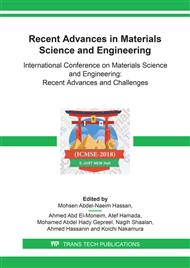[1]
D. Ahuja, M. Tatsutani, Sustainable energy for developing countries, SAPIENS 2(1) (2009) pp.1-16.
Google Scholar
[2]
M. Zeman, Thin-Film Silicon PV Technology, JEE 61(5) (2010) pp.271-276.
Google Scholar
[3]
S. Pizzina, Advanced Silicon Materials for Photovoltaic Applications, Wiley (2012) pp.35-40.
Google Scholar
[4]
M. Zeman, J. Krc, Optical and electrical modeling of thin-film silicon solar cells, Mat Res 23 (4) (2008) pp.889-898.
DOI: 10.1557/jmr.2008.0125
Google Scholar
[5]
S. Fu, The characterization of Hydrogenated Silicon Thin-film using constant Photocurrent Method, Msc thesis National Center University Taiwan (2009) pp.8-10.
Google Scholar
[6]
A. Luque, S. Hegedus, Handbook of Photovoltaic Science and Engineering, Wiley (2003) pp.505-506.
Google Scholar
[7]
D. L. Staebler, C. R. Wronski, Reversible conductivity changes in discharge produced amorphous Si, APL 31 (4) (1977) p.75.
DOI: 10.1063/1.89674
Google Scholar
[8]
P. Cuony, Optical Layers for Thin-film Silicon Solar Cells, PhD thesis Federal Institute of Technology Suisse (2011) pp.4-6.
Google Scholar
[9]
T. Roschek, Microcrystalline Silicon Solar Cells Prepared by 13.56 MHz PECVD Prerequisites for High Quality Material at High Growth Rates, Research Center Jülich in the Helmholtz Association (2003) pp.27-29.
DOI: 10.1557/proc-664-a25.5.1
Google Scholar
[10]
G. Maxwell, Characterization and Modeling OF CdCl2 Treated CdTe/CdS Thin-Film Solar Cells, PhD thesis Colorado State University Colorado (2010) pp.24-31.
Google Scholar
[11]
A. Robert, Hydrogenated Amorphous Silicon. Syndicate of Cambridge University Press (1991) pp.3-10.
Google Scholar
[12]
JG. Simmons, GW. Taylor, Nonequilibrium Steady-State Statistics and Associated Effects for insulators and Semiconductor Containing an Arbitrary Distribution of Traps, Phys Rev 4(2) (1971) pp.502-511.
DOI: 10.1103/physrevb.4.502
Google Scholar
[13]
A. Kolodziej, W. Staebler, effect in amorphous silicon and its alloys, Opto-Electron Rev12 (1) (2004) pp.21-23.
Google Scholar
[14]
N. Wang, Improving stability of amorphous silicon using chemical annealing with helium, J Non-cryst Solids 352 (2006) p.1937-(1940).
DOI: 10.1016/j.jnoncrysol.2006.02.033
Google Scholar
[15]
S. Michard, Microcrystalline silicon absorber layers prepared at high deposition rates for thin-film tandem solar cells, Eur Phys J pv4 (45201) (2013) pp.1-6.
DOI: 10.1051/epjpv/2013026
Google Scholar
[16]
B. Modtland, Improving the light-induced degradation of hydrogenated amorphous silicon solar cells using fabrication at elevated temperatures and low pressure, PhD thesis Iowa State University USA (2013) pp.13-25.
DOI: 10.31274/etd-180810-3305
Google Scholar
[17]
T. Mates et al, Effect of substrate temperature and hydrogen dilution on thin silicon film system deposited at low substrate temperature, 3rd World Conference on Photovoltaic Energy Conversion Osaka Japan, 2003 p.1664.
Google Scholar
[18]
Y.H. Chen, Hydrogen dilution on an undoped silicon oxide layer and its application to amorphous silicon thin-film solar cells, Mat Sci Semicon Proc 41 (2016) pp.312-316.
DOI: 10.1016/j.mssp.2015.09.024
Google Scholar
[19]
M. Brinza, Thin film silicon n–i–p solar cells deposited by VHFPECVD at 100 1C substrate temperature, Sol Energ Mat Sol C (2008) pp.1-4.
Google Scholar
[20]
K. Zellama, Systematic study of light–induced effects in hydrogenated amorphous silicon, Phys Rev B 45(23) (1992) pp.13314-13322.
DOI: 10.1103/physrevb.45.13314
Google Scholar
[21]
JN. Lee, Effect of deposition temperature on the crystallization mechanism of amorphous silicon films on glass, Jpn J Apll Phys 36(11) (1997) pp.6862-6867.
Google Scholar
[22]
N. Parvathala, Light induced degradation of amorphous silicon containing nanocrystalline silicon, J Apll Phys 14(047124) (2014) pp.1-10.
Google Scholar
[23]
X. Wang, Microstructure evolution of amorphous silicon thin films upon annealing studied by positron annihilation, Mat Sci Semicon Proc 56 (2016) pp.344-348.
DOI: 10.1016/j.mssp.2016.09.019
Google Scholar
[24]
Y. Luo, The influence of annealing temperature upon the structure of a Si:H/c-Si thin-films, J Non-cryst Solids 471 (2017) pp.379-383.
DOI: 10.1016/j.jnoncrysol.2017.06.026
Google Scholar
[25]
P. Bellanger, Understanding phenomena of thin silicon film crystallization on aluminum substrates, Energ Procedia 84 (2015) pp.156-164.
DOI: 10.1016/j.egypro.2015.12.309
Google Scholar
[26]
J. Bae Park, Plasma electron annealing method for recrystallization of a-Si thin films. Thin Solid Films, 622 (2017) pp.111-114.
DOI: 10.1016/j.tsf.2016.12.025
Google Scholar
[27]
D. Kar, Structural characterization of silicon thin-film super lattice grown at low temperature, Superlattice microst (2017) pp.1-11.
Google Scholar
[28]
WZ. Cui, Preparation Principle Technology and Application of Thin Films, 2nd edition Metallurgical Industry Press Beijing (2003) p.151.
Google Scholar
[29]
G. Chris, Hydrogen in silicon: Fundamental properties and consequences for devices, J Vac Sci Technol A 16(3) (1998) pp.1767-1769.
Google Scholar
[30]
M. Ohring, Materials Science of Thin Films, 2nd edition (2002) p.327.
Google Scholar
[31]
H. Cheng, Effects of Substrate Temperature on the Growth of Polycrystalline Si Films Deposited with SiH4+Ar, J Mater Sci Technol 25 (4) (2009) pp.489-491.
Google Scholar
[32]
LQ. Song, Effect the substrate temperature on the growth and properties of boron-doped microcrystalline silicon film, Chin J Phys 15(1) (2006) pp.214-216.
Google Scholar
[33]
N. M. Hwang, Non-Classical Crystallization of Thin Films and Nanostructures in CVD and PVD Processes, Springer Science Business Media Dordrecht, 2016 pp.1-2, 83, 94-95, 163-164, 307-308.
DOI: 10.1007/978-94-017-7616-5_8
Google Scholar
[34]
J. Springer, Absorption loss at nanorough silver back reflector of thin-film silicon solar cells, J Apll Phys 95 (3) (2003) pp.1427-1429.
DOI: 10.1063/1.1633652
Google Scholar
[35]
K. M. Azizur Rahman, Nanocrystalline Silicon Solar Cells Deposited via Pulsed PECVD at 150°C Substrate Temperature, PhD thesis (2010) pp.54-56.
Google Scholar
[36]
S.N. AGBO et al, Deposition Pressure and Hydrogen Dilution Effects on the Spectral Response of Thin Film Nanocrysyalline Silicon Solar Cells, Journal of Ovonic Research 9(1) (2013) pp.2-4.
Google Scholar
[37]
G. Ganguly et al, Defect formation during growth of hydrogenated amorphous silicon, Appl Phys 47 (1993) p.3661.
DOI: 10.1103/physrevb.47.3661
Google Scholar
[38]
Y. Nasuno et al, Passivation of oxygen–related donors in microcrystalline silicon by low temperature deposition, Appl Phys 78(16) (2001) p.2330–2332.
DOI: 10.1063/1.1364657
Google Scholar
[39]
LQ. Song, Effect the substrate temperature on the growth and properties of boron-doped microcrystalline silicon film, Chin J Phys 15(1) (2006) pp.214-216.
Google Scholar


